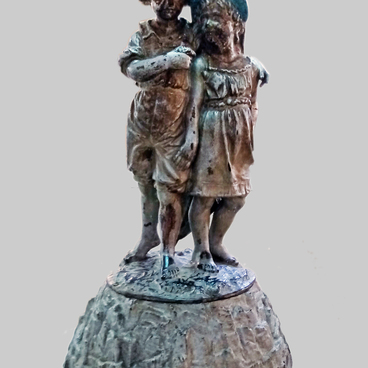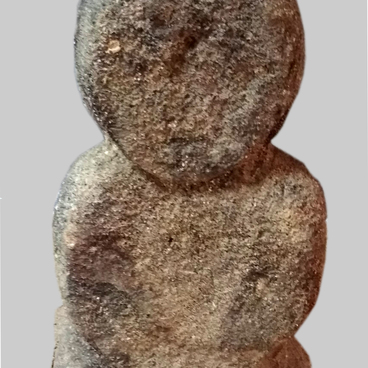In 1959, a warrior’s burial place dating back to the end of the first millennium AD was accidentally discovered during construction works on Lake Sineglazovo. The deceased was buried in a silk robe or caftan. Scientists managed to reconstruct the repetitive parts of the print (rapport) measuring 51 × 30 cm. The fabric was made using the twill weave technique, with two warps and three wefts. The images of horsemen riding in one direction in columns are woven with blue and green threads on a brownish-golden background. The horses are moving calmly. Their harnesses are abundantly decorated with badges and pendants.
The figure of the king is disproportionately large compared to the horsemen. He is wearing in a long caftan with a waist belt and ankle-length harem pants. His body and arms are protected by plate armor. On his head is a jagged crown with a crescent and ball crest and fluttering ribbons; hair. The king is holding a long spear with two flags in his right hand and a small shield in his left hand; his sword is hanging at his right hip.
The royal horse is also disproportionately tall. It is depicted in a traditional calm movement pose with a raised left front leg. Its tail is tied at the top. Badges and pendant decorations are depicted on the harness’s long belt.
The State Hermitage Museum restorer Anna Ierusalimskaya, who restored and studied the Chelyabinsk fabric in the 1960s, says that the theme and style of the print and some of its details (horse posture, crown features), as well as the technological parameters of the fabric, indicate that it was made in Iran around 8th or 9th century. The Arabs dominated Iran at the time, but the traditions of Sasanian art were intact, as Islam still tolerated the images of people. The Chelyabinsk fabric suggests that Sasanian traditions influenced the cultures of the peoples of Eurasia and were popular among nomadic tribes. The fact that the nobility of the Ural-Kazakh steppes used expensive Iranian fabrics indicates the widespread presence of intermediary trade and the mobility of nomadic groups, as well as their active participation in the struggle between the clans of Iran and Central Asia.
The figure of the king is disproportionately large compared to the horsemen. He is wearing in a long caftan with a waist belt and ankle-length harem pants. His body and arms are protected by plate armor. On his head is a jagged crown with a crescent and ball crest and fluttering ribbons; hair. The king is holding a long spear with two flags in his right hand and a small shield in his left hand; his sword is hanging at his right hip.
The royal horse is also disproportionately tall. It is depicted in a traditional calm movement pose with a raised left front leg. Its tail is tied at the top. Badges and pendant decorations are depicted on the harness’s long belt.
The State Hermitage Museum restorer Anna Ierusalimskaya, who restored and studied the Chelyabinsk fabric in the 1960s, says that the theme and style of the print and some of its details (horse posture, crown features), as well as the technological parameters of the fabric, indicate that it was made in Iran around 8th or 9th century. The Arabs dominated Iran at the time, but the traditions of Sasanian art were intact, as Islam still tolerated the images of people. The Chelyabinsk fabric suggests that Sasanian traditions influenced the cultures of the peoples of Eurasia and were popular among nomadic tribes. The fact that the nobility of the Ural-Kazakh steppes used expensive Iranian fabrics indicates the widespread presence of intermediary trade and the mobility of nomadic groups, as well as their active participation in the struggle between the clans of Iran and Central Asia.

